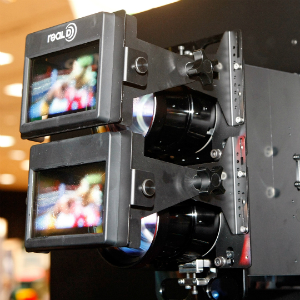Report: 3-D Lenses and Lazy Theaters Dim 2-D Projection by Up to 85 Percent
 Boston Globe film critic Ty Burr confirms what you may have already noticed at your local chain multiplex: picture quality sucks, and an unspoken company cost-cutting policy is to blame. Thanks to a perfect storm of practices uncovered at an AMC Loews in Boston, endemic to the company and other chains -- going cheap on projection, sweetheart deals with Sony, sheer laziness -- ticket buyers are getting shafted at 2-D screenings dimmed by 50 to 85 percent brightness.
Boston Globe film critic Ty Burr confirms what you may have already noticed at your local chain multiplex: picture quality sucks, and an unspoken company cost-cutting policy is to blame. Thanks to a perfect storm of practices uncovered at an AMC Loews in Boston, endemic to the company and other chains -- going cheap on projection, sweetheart deals with Sony, sheer laziness -- ticket buyers are getting shafted at 2-D screenings dimmed by 50 to 85 percent brightness.
According to the report, the issue affects AMC, National Amusement, and Regal Theaters, and comes down to a single piece of equipment: The add-on 3-D lens attached to Sony 4K digital projectors, which creates the 3-D image projected onto a theater screen. Those 3-D lenses must be removed for subsequent screenings of 2-D films, or the image is dimmed considerably. And for a few reasons -- none of them good -- this necessary step is not being taken.
At fault: Theater management, who are allegedly cutting costs by simply not making the switch, which requires specialized training (read: minimum wage-earning theater employees can't just push a button on the Sony set-ups as they might to just run a film). [Add to that the fact that other projection systems make the switch from 3-D to 2-D literally as easy as turning the filter on and off with a button, as a projectionist source describes to Movieline.] The Globe quotes a local projectionist in pinpointing where the decision not to remove the Sony projector lens filters originates:
"I can tell you who's not [making the call], and it's not the manager,'' said one projectionist who has worked at a number of area theaters, including the Common, and who also preferred to remain anonymous. This man -- let's call him the Phantom Projectionist -- believes that unspoken AMC corporate policy is to keep 3-D lenses on for 2-D showings.
"If we knew a house would be opening 'Harry Potter' and it wasn't going to be 3-D,'' he said, "I would ask them to swap the lens out and it would either go nowhere or come back with a negative from the regional technician, usually with the impression that it came from above.''
The most concerning part of this whole kerfuffle is that, when reached for comment by the Globe, theater representatives played coy on the matter:
After multiple requests, Sony declined through a spokesman to respond to questions about its digital projection equipment. Executives at the major theatrical chains are equally unwilling to discuss the matter. When contacted for this article, a spokesman for Regal, the nation's largest multiplex operator, e-mailed the following statement: "Patron response has been overwhelmingly positive toward digital cinema and all of the associated entertainment options provided by this technology."
Ultimately, audiences have to stand up to demand better (optimal!) projection themselves. Why settle for crappy exhibition if you're paying to see, at the very least, the film as it was intended to be seen? Filmmakers, especially those who lent support to theater owners over VOD, should use their leverage as well; a poor movie-going experience can only hurt a film in release (or pre-release, in screenings for critics who often attend review screenings in chain theaters, including AMC, nationwide).
· <a href="http://www.boston.com/ae/movies/articles/2011/05/22/misuse_of_3_d_digital_lens_leaves_2_d_movies_in_the_dark/?page=1
" target="_blank">A movie lover's plea: Let there be light [Boston Globe]
[Photo of Sony SRXR220 4x digital cinema projector with a RealD 3D system: Getty Images]

Comments
This kinda thing is why it is frustrating for someone like me to go to a theater. I am so hypercritical of the quality being projected I went and complained to the projectionist after the first 10 minutes of the original "Matrix", stating the image was too green. He assured me it was supposed to look that way... I didn't believe him...